|
Your upcoming movie Tales of Frankenstein - in a few words, what is
it about?
It’s about one hour and 52 minutes. But seriously, it’s an Amicus-type
anthology [Amicus story - click here]
adapted from four stories published in a book by me also called
Tales of Frankenstein. Each story takes place in a different time period and
place starting in 1887 Bavaria. And each is filmed in a certain style. The
first and last stories are very much like Hammer, with a bit of
Allied Artists
and American International in the fourth, which is set in 1957 Transylvania.
There is also a present-day “frame story” featuring the original
Frankenstein Monster, played by Scott Fresina, that ties together the other
four.
Frankenstein
is a character you've come back to time and again over the years, ever
since your amateur movies in your teenage years - so what do you find so
fascinating about the subject, and what do you think will make Tales of Frankenstein
stand out of the crowd of Frankenstein
movies? I can’t really explain my ongoing fascination,
but I can tell you how it all began. When I was around six or seven years
old, I was sitting next to my Mom at the Music Box Theatre in Chicago
(where more than half a century later I’d premiere my movie Blood
Scarab) watching the movie Tap Roots, in which Boris Karloff [Boris
Karloff bio - click here] played an
American Indian. My Mother whispered to me that he was the actor who
played
Frankenstein, a name I’d never heard before. On the walk
home I asked her who
Frankenstein was and she answered that it was
“a man brought back from the dead.” For some unknown reason, that
response intrigued me tremendously. It was for me a kind of epiphany. And
from that moment onwards, I tried to learn as much as I could about the
character, who and what it was, what he looked like, etc. This was years
before I’d ever see my first
Frankenstein movie. Maybe there’s some
unconscious identification of mine with Victor Frankenstein (I know, I
know, the standard ID everyone is supposed to be with the Monster, because
the character was misunderstood, etc). I like to create things, make
things happen, and that’s what Victor did, albeit with results somewhat
more tragic than the things I’ve ever done!
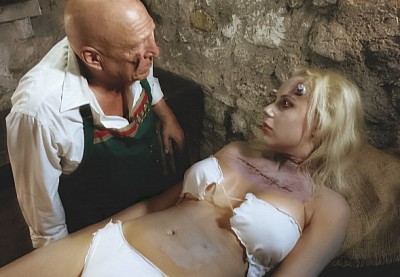
segment My Creation, My Beloved |
What made you choose the anthology format for Tales of Frankenstein, and what are the advantages and challenges shooting
an anthology as opposed to just a feature film?
For one thing, there have been so many features either based on Mary
Shelley’s original story and characters. What hasn’t already been
done? But there’s another reason. Some years ago I was approached by an
independent producer who wanted me to write a script for a film he would
then make. There was no real money involved, but I thought it might be
good to get another screen credit on my resume. I remembered those old Amicus
movies and had on hand about two dozen published stories in my
Tales of Frankenstein prose collection. So, I thought, if I just adapted
some of those stories, I could save a lot of time in thinking up plots. So
that’s what I did. When we parted our ways due to creative differences,
I decided to just do the movie myself. At the time I was planning a
vampire film for my next project. But then I remembered that the 200th
anniversary of Mary Shelley’s classic novel was coming up and I wanted
to capitalize on that. Hence, Tales of Frankenstein took priority on my
schedule. The advantages? As I was financing the movie myself, I only had
to come up with enough money at one time to shoot one segment, rather than
coming up with the full amount to make the entire movie. The challenges?
Each segment had to have its own cast of actors, often different crew
members (because people I wanted to work with again had gotten other gigs)
and each had to have the correct wardrobe and props to match the place and
time period. In one sequence (Madhouse of Death), for example, set
in 1948 Los Angeles, we needed a vintage car, telephone, medical equipment
and so forth, even a 1940s cigarette pack – all of which we found!
|
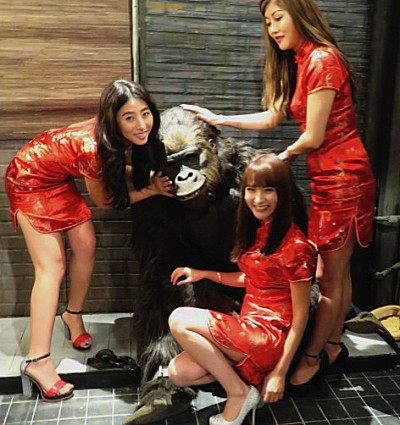
segment Madhouse of Death |
I've
read that the segments of Tales of Frankenstein
are all based on
short stories written by you - so when you wrote the stories, did you ever
plan for them to be filmed one day, and how close did you actually stay to
your own source material?
No, filming them was not in my
remotest imagination when I wrote them – otherwise they’d have been
more “cinematic” from the get-go. As it turned out, each one required
a lot of revising to make them work as movies, rather than scenes imagined
in a reader’s head. For example, the original My Creation, My
Beloved was written as a kind of Lovecraft story and was not very
visual, so that had to be much reworked. The screen version is more based
on Roger
Corman’s Poe films of the 1960s [Roger
Corman bio - click here]. Madhouse of Death, even
before it was a prose story, was a very short radio drama (which is
included on the DVD) for Jim Harmon’s late-1960s Mini-Drama series. It
first required revisions before becoming a piece of prose… and a lot
more before reaching the screen. For example, the characters of Mogambo
and the three Annas, so pivotal in the movie (not to mention the entire
island fantasy scene), are not in the short story at all, let alone in the
radio version. Dr. Karnstein’s Creation was probably the easiest
to adapt and almost became part of a movie back in the 1970s. The story
was first published in a British paperback book collection titled The
Rivals of Frankenstein, edited by Michel Parry. Milton Subotsky, who
produced those Amicus anthology films
[Amicus story - click here]
like Asylum and Torture
Garden,
wanted to make a Rivals of Frankenstein movie including my “Karnstein”
story. But then Subotsky died, and that was the end of that project. So in
a way Dr. Karnstein’s Creation has come full circle, finally
making it to the screen.
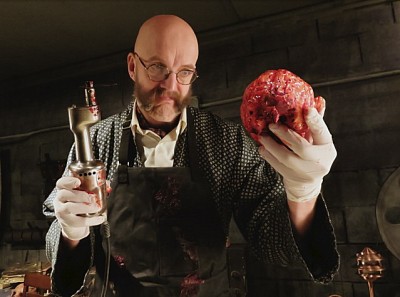
segment Dr. Karnstein's Creation
|
Do talk about Tales of Frankenstein's approach to horror for a bit!
Very traditional, even retro, the kind of film one usually thinks of
when you say “Frankenstein
movie”. I certainly didn’t want to make a
movie like Van Helsing,
I, Frankenstein or the Tom Cruise Mummy! And even
if I wanted to, I couldn’t afford it. I didn’t want to do just another
CGI fest where the monsters were portrayed like superheroes. I loved the
old movies made by Universal and
Hammer, also the
Corman Poes
and film
noir, the latter being my style for Madhouse of Death. So those were
the styles I went for, with all the old tropes – monsters (played by
actors in practical make-ups), mad scientists, castles, laboratories,
villagers with torches, etc. In Madhouse of Death, because it was set in the
Forties, I was adamant about using that famous lightning stock shot seen
in Bride of Frankenstein and so many other movies and television programs
– sometimes again and again, sometimes flopped or upside down, in the
same show! So that’s what I did. But it took me a very long time to find
where to obtain that shot. I also wanted to use sound effects in that
episode that became clichés back in the day, like the howling dog and
thunder crashes, which I luckily found on an old sound effects record.
Maui Holcomb, my sound designer, told me any other director or producer
would have fired him for using those old way-too-familiar sounds!
What
can you tell us about your overall directorial approach to your story at
hand?
|
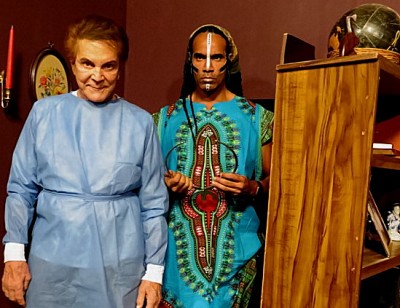
|
I can pretty much see the whole film in my head
before I get on set. Because I am also the writer, I often – to the
detriment of my actors – revise, rewrite and even drop an entire scene
while we’re shooting it, which drives everyone nuts. To the horror of my
first assistant directors, I don’t make a shot list. I’ve learned from
past experiences that, for me at least, that’s a waste of time. No
matter how much I plan in advance, how I work out my shots and even have a
plan B and C in case there is a problem preventing plan A, things change
when you are actually on set on shooting day – an actor or prop not
showing up, a vehicle that can’t be moved in the way of a planned shot,
the sun is in the wrong place, somebody is playing a stereo nearby, and so
forth. A lot of what I then have to do is make up stuff as I go along. So,
I start figuring out my shots and everything after I arrive at the
location, while actors are getting made up, lights are tweaked and so on.
As to my writing, I can be ruthless with my own scripts, sometimes tossing
out whole pages. It seems like the more lines I remove, the better the
scene plays.
Do talk about your key cast, and why exactly these
people? I was very picky about picking my cast – which is
very large, especially for an independent, modestly budgeted move. I have
57 actors (as many as Heinz has varieties of pickles)! I didn’t
want this movie to be like so many indies, where there are about a half
dozen actors who all look the same and seem to have just got out of acting
school. I also stayed away from actors, even well-known ones, who were
type cast in appearing in bad B movies. We held a lot of auditions and
chose only the best actors available to us, based upon both their look and
their acting ability. We have some really good character faces backed up by
strong acting chops, fortunately. There were a number of “name actors”
that didn’t require auditioning, as I already knew what they could do
– including Jerry Lacy, Ann Robinson, Beverly Washburn, Mel Novak, T.J.
Storm, John Blyth Barrymore, Douglas Tait (Google them) and others. I am
very pleased with the quality of actors in this movie.
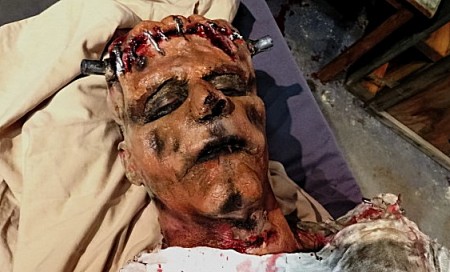
segment Dr. Karnstein's Creation |
A few words about the shoot(s) as such, and the
on-set atmosphere? Of course, there were always tense and
stressful moments, especially when you are shooting very fast on 10-hour
or longer days. But for the most part everyone seemed to have a good time.
I know I surely did! For me making this movie, despite a setback or two
now and then, was a joy, perhaps my most pleasurable moving-making
experience I’ve ever had.
The $64-question of course, when and
where will Tales of Frankenstein
be released? That
requires a three-part answer and the answer could always change. We’ve
entered the movie at Screamfest, and, if it’s accepted, that’s where
the “World Premiere” will be. The DVD and Blu-ray are currently
scheduled for an October 19 release, just in time for Halloween and
from the usual places, like Amazon. The “Cast & Crew Premiere,”
which will be in a theatre on October 24, is the first public screening.
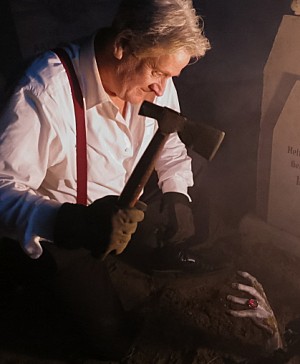
segment Crawler from the Grave
|
Any
future projects beyond Tales of Frankenstein
you'd like to share? Of
course (I’m always busy and have irons in the proverbial fires)! Before
I decided to make Tales of Frankenstein
myself, I’d planned on making a
modern day, urban-set vampire film, based on Sheridan Le Fanu’s Carmilla
character. But based on the positive response I started getting on Tales of Frankenstein, I
decided that the next project would have to be Tales of Frankenstein, Book
2. I’ve already written the script and have some actors in mind. I do
still want to do that vampire film, but for now it’s on the back burner
right behind Tales of Frankenstein, Book 2. As
far as I know, you've been making movies since age 9 - so do you even
still remember what sparked your interest in movies in the first place?
Those
were, of course, amateur films, AKA “home movies” (and excerpts from
the
Frankenstein titles are a “bonus feature” on the Tales of Frankenstein
DVD). And I hope I’ve gotten better at movie-making
over the years! Fortunately our family owned a 16mm movie camera and
projector. At age nine I saw The Beast from 20,000 Fathoms and,
being already into dinosaurs, I wanted to show that movie in home on our
screen, whenever I wanted. Of course, back then that was impossible to do.
So my solution was to “remake” the film myself in my backyard. It all
just evolved from there. Back
in the 1950s and 60s, you made amateur fan movies before there actually was
such a thing - so do talk about your endeavours from back when for a bit,
and what are your thoughts today looking back on some of these films?
Well,
other people – including Hugh Hefner – were making their own amateur
monster movies before me, but I wasn’t aware of them. As far as I knew,
I was the first and only person doing this. But I learned a lot by making
those films – because there weren’t books or articles or videos to
show you how to do it. The studios back then carefully guarded their
secrets and tricks. I learned (like Victor Frankenstein) by experimenting
and doing – things like make-up, rear projection, lapse dissolves,
stop-motion animation, editing and, most important, storytelling. Today,
with home video cameras, computers, how-to-do-it books, etc, making
movies is a lot easier – but, in my opinion, less fun. Eventually,
you transitioned from your amateur movies to professional screenwriting -
so how did that happen, and do talk about your career as screenwriter on
many a popular TV show! I always try to take advantage of
an opportunity that comes my way. It’s said that opportunities are never
wasted; they’re just passed on to someone else. A friend named
Kevin Glover, with whom I’d worked before on other projects including a
short-lived cable-access TV show, asked me if I’d like to write a video
project of his. Seeing that as a career opportunity, I agreed – which
eventually led to my directing it (another opportunity). I did several
video projects with Kevin and one day he asked if I’d like to direct a
movie he would be producing. You already know my answer and that turned
out to be my first professional film, Dinosaur Valley Girls. As for all
those TV shows, most of them animation (and very poorly animated!), those
were just jobs, written to meet certain network, network censors and toy
company standards, some of them, like Transformers and GI
Joe, really no
more than half-hour commercials. All were written toward a low common
denominator. l learned early on that if I did anything too creative or
beyond the norm, I would not be getting another assignment on that show.
There are only a small number of those shows for which I have even a
little personal pride.
|
|
 |
|
|
You also wrote for many a
comicbook over the years - so do talk about that aspect of your career,
and some of the books you wrote for! And how does writing for a comicbook
compare to screenwriting?
I wrote for just about all the comic book companies, mostly back in the
1970s – Marvel,
Warren, Gold Key, Charlton, DC,
Red Circle, Skywald, First, you name it. Most of those stories were just cranked out, first
draft. My “baby” was The Occult Files of Dr. Spektor, which for me was
a quite personal book. It was influenced a lot by things like old movies,
Dark Shadows and pre-Code comics I’d read. I really didn’t enjoy sword
and sorcery, although I wrote a ton of it. Superheroes were fun. I really
enjoyed writing Captain America, The Invaders, What If and, for the great
Russ Manning, Tarzan. Arguably my specialty is horror and I’m currently
back in that business, writing what I think are my best horror comics
stories ever, for The Creeps magazine. Oh, and lest I forget, there is a
Tales of Frankenstein graphic novel that will be out later this year,
published by Pulp 2.0 Press. I did the adaptation, there are some great
artists doing the stories and legendary “Jaunty” Jim Steranko wrote
the introduction.
A few words about Donald F.
Glut, the novelist? To be honest, I don’t enjoy writing
novels. They are a chore for me. But I have written quite a few, a dozen
featuring my favorite Monster in a series, also available from Pulp 2.0
Fiction, called The New Adventures of Frankenstein. They include a
new 12th book that I did enjoy writing, like visiting an old friend after
some 40 years – Frankenstein: The Final Horror. And writing novels is
still better than having a day job. Besides fiction, you also wrote a
plethora of non-fiction book, including several definite books on movie
monsters, so do talk about those books for a bit, and your fascination
with monsters as such! I’ve been fascinated by movie
monsters ever since I saw, upon its original release, Creature from the
Black Lagoon … and soon afterwards, read that classic article in
Colliers magazine about the Bud Westmore make-up lab at Universal and how
the Gill Man suit was made Oh, how I wanted to visit that place! Those were
two more epiphanies in my life, the movie and that article. From that
point on, monsters were no longer scary, they were “neat.”
A bit off topic, but a mutual
friend told me that you also used to throw "prehistoric parties"
at your place - care to elaborate?
Yes, I did that for 10 years – an annual “Prehistoric Party.”
They were great! I’d get as many as 300 people, some showing up in
costume, e.g. explorers, cavemen and, my favorite, cavegirls. On the menu
were items like “lava hot chili” and bubbling/steaming punch served
from a prop volcano. I miss those parties, but they got too expensive and
time-consuming, not to mention keeping out the crashers (news always got
around) and, worst of all, the before and after cleanup time. You can see
photos from some of those events on my www.donglutsdinosaurs.com
website.
After your
experiences as an amateur filmmaker, it actually took you until 1996 to
direct your first professional feature film, Dinosaur Valley Girls
- so what can you tell us about that movie, and what took you so long to
get back into directing?
I kept getting side-tracked. I had some bad experiences with the
faculty at USC film school, from which I graduated in 1967 with a BA
degree. So when I got out of college, I seized upon another opportunity,
answering an ad on the Musicians Union bulletin board for a bass guitar
player. Always having a desire to be a rock star, I answered the ad, which
led to a few years with the Penny Arkade, a group produced by Monkee Mike
Nesmith. When that collapsed, more opportunities came up and I went with
them… doing a little acting (including a network TV commercial with Dick
Clark), writing non-fiction books and then comics. Anything to avoid
getting a real job! When Roy Thomas left Marvel
as editor in chief and a
new regime came in, that was pretty much the end of all of us
“bullpenners” living on the West Coast. The natural next step was, as
this is where the action was, going into TV animation, which offered a
much better deal than Marvel
or the other comic-book companies gave. And
writing comic books taught me how to come up with stories fast and to
think visually, which are important in animation. In fact I learned
how to direct by writing animation where, rather than write in master
scenes, every shot, cut and camera move is usually written into the
script. In other words, the scripts are directed on paper by the writer.
So by the time I got to Dinosaur Valley Girls, directing was relatively
easy. That was a fun project, as it was a send-up of movies like one of my
old favorites, One
Million B.C. and its later remake. As to the
non-fiction books, those tended to be books I wanted to read, but no one
had written them – so I wrote them myself and then read them! That way I
could also be confident that they’d be written the way I wanted them to
read!
How would you describe yourself as a
director?
|
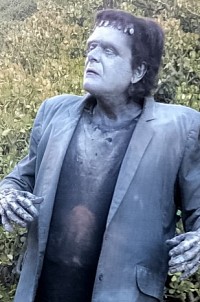
|
 |
 |
Feeling lucky?
Want to
search
any of my partnershops yourself
for more, better results?
(commissions earned) |
The links below
will take you
just there!!!
|
|
 |
|
I am 5’ 9.5” tall, 160 pounds, brown hair,
blue eyes and right-handed. Filmmakers, writers, whoever else who inspire
you? My greatest inspirations as far as writing is
concerned have been Edgar Allan Poe, Edgar Rice Burroughs and Stan Lee. Maybe include Al Feldstein on that list. My director heroes have been and
probably always will be Roger Corman [Roger
Corman bio - click here] and Stanley Kubrick, I’ve learned
so much from the work of all of them. Your favourite movies? As
to horror and monster movies, Bride
of Frankenstein, the original King
Kong, Island
of Lost Souls, the 1940 One
Million B.C., The
Black Cat (Karloff-Lugosi version [Boris
Karloff bio, Bela Lugosi
bio]), The Exorcist,
House of Wax, way
too many to list or even think about. As to the non-horrors, my favorite
movies include The Godfather (entire saga) and, perhaps my
number one favorite, Red River. I have others like The
Adventures of Robin Hood, On the Waterfront, The
Grapes of Wrath, Of
Mice and Men, A Hard Day’s Night, Jailhouse Rock
and 12 Angry Men, again so many more, with some guilty pleasures
like The George Raft Story, Teenage Doll and High School
Confidential. ... and of
course, films you really deplore?
Pretty much anything by
David Lynch except The Elephant Man, The
Rats Are Coming, the Werewolves Are Here, and most Star
Wars movies. I’m sure I could list a lot more. Your/your movie's
website, Facebook, whatever else? My production company’s
website is www.pecosborn.com, where you can learn all about the movies
made by my new company Pecosborn Productions, and also see some of
their related merchandise (don’t dream it, buy it!), and my
personal/professional website is www.donaldfglut.com. Anything else you're
dying to mention and I have merely forgotten to ask? You
didn’t ask me what is the capital of Alabama. But I’d have to look
that up. Thanks
for the interview! You are welcome and my pleasure!
|